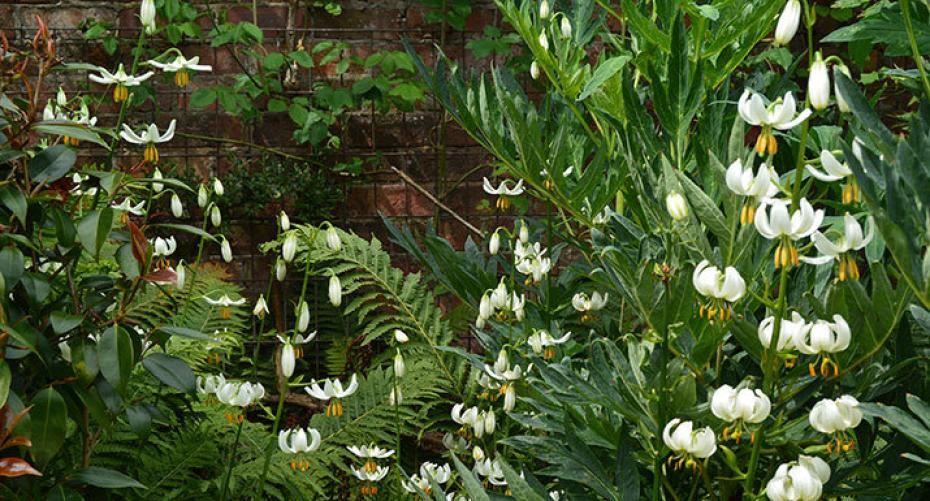Follow our planting guide for colour along damp, shady river banks
One of the trickiest areas of a garden to plant up is a permanently damp, shady position; but there are solutions for those shady stream banks. It is much easier to choose plants which will thrive in any given situation than changing the growing conditions; which usually involves some sort of drainage works and landscaping.

Hostas
There won’t be many flowers as they need sunshine to give a really good show and it’s no good planting spring bulbs which flower before the canopy closes over as they will just rot. These plants are recommended for permanently damp areas, not parts of the garden which are really waterlogged and boggy, for these areas you will need to plant pond marginal plants. You can achieve interest by choosing plants with differing leaf shapes and colours.
If you have an acid soil you can have a fantastic show of rhododendrons and camellias in spring. Flowering in late winter to early spring is Mahonia aquifolium which has lovely bright yellow flowers followed by dusky dark blue berries, which are loved by birds. Hellebores are always a welcome sight in spring and as they cross pollinate quite freely you easily increase your stock, and the most exciting thing is that you never know what the seedlings are going to look like.
Some plants self-seed quite prolifically which is always good news if you have quite a large patch to plant, but they can become a nuisance if you only have a small patch which is already crammed. There are several plants on the list which provide fantastic ground cover, which cuts down on the weeding and makes it less likely the prolific self-sowers can germinate.
There are some plants which flower in summer, but the amount of flowers the plant will produce depends upon the depth of shade; so don’t expect a profusion of flowers in this difficult area. If you have very deep shade try pruning out some of your tree branches or raising the canopy by taking out low branches. If this is not an option you can always add interest by including some statuary or creating a stumpery with old tree roots and then creating dryer planting pockets within the roots.

Iris ensata Gracieuse
Recommended plants:
Trees
- Acer cappadocicum
- Acer griseum
- Betula nigra
- Cercidiphyllum japonicum
- Salix (Willow)
- Taxus baccata & cultivars (Yew)
Grasses & Ferns
- Adiantum venustum
- Arundinaria
- Asplenium scolopendrium
- Athyrium filix-femina ‘Frizelliae’
- Cryptogramma crispa
- Dicksonia antartica
- Dryopteris wallichiana
- Matteuccia struthiopteris
- Phyllostachys
- Polypodium vulgare
- Polystichum setiferum
- Sasa - large leaved bamboo, can be quite invasive
- Woodwardia radicans

Symphytum officinale (Common Comfrey)
Herbaceous
- Ajuga reptans & cultivars (Bugle) - ground cover
- Alchemilla mollis (Lady’s Mantle)
- Aruncus dioicus (Goat’s Beard)
- Astilbe
- Brunnera
- Dicentra (Lamprocapnos) spectabilis (Bleeding Heart)
- Digitalis (Foxglove)
- Epimedium
- Erythronium dens-canis (Dog’s-tooth Violet)
- Geranium sylvaticum (Wood Cranesbill)
- Helleborus
- Hemerocallis (Day Lily)
- Heuchera
- Heucherella
- Hosta
- Ilex aquifolium & cultivars
- Iris foetidissima
- Iris sibirica
- Lamium maculatum
- Ligularia
- Meconopsis cambrica (Welsh Poppy) - self-seeds
- Primula - candelabra
- Pulmonaria officinalis (Common Lungwort)
- Rodgersia pinnata ‘Superba’
- Symphytum officinale (Common Comfrey)
- Thalictrum delavayi (Chinese Meadow Rue)
- Tricyrtis formosana (Toad Lily)
Shrubs
- Aucuba japonica
- Camellia
- Cornus alba (Dogwood) - grown for winter stem colour
- Cornus sanguinea
- Cornus sericea
- Cotoneaster
- Daphne - not alpine species
- Fatsia japonica
- Fothergilla major
- Gaultheria
- Hypericum androsaemum
- Hypericum calcyinum
- Leucothoe fontanesiana
- Ligustrum (Privet)
- Mahonia aquifolium
- Osmanthus x burkwoodii
- Osmanthus heterophyllus
- Pachysandra terminalis - ground cover
- Prunus laurocerasus
- Prunus lusitanica subsp. azorica
- Pieris
- Rhododendron
- Ribes alpinum
- Rubus odoratus
- Rubus spectabilis
- Rubus tricolour
- Ruscus
- Sarcococca
- Skimmia
- Symphoricarpos (Snowberry)
- Vaccinium vitis-idaea - ground cover
- Viburnum davidii
- Viburnum rhytidophyllum
- Vinca - ground cover

Lakeland Horticultural Society garden, Holehird, Windermere
Plants shown: Aruncus, Dicentra, Welsh Poppy, Iris sibirica, Martagon Lily, foxglove, hosta, ferns, Thalictrum
Climbers
- Clematis ‘Nelly Moser’
- Hedera helix ‘Arborea’ - can also be ground cover
- Hydrangae petiolaris
- Jasminum nudiflorum
- Lonicera nitida
- Lonicera tellmanniana
For more information, hints and tips on gardening just get in touch with our team in the Outdoor Plant department here in store.


